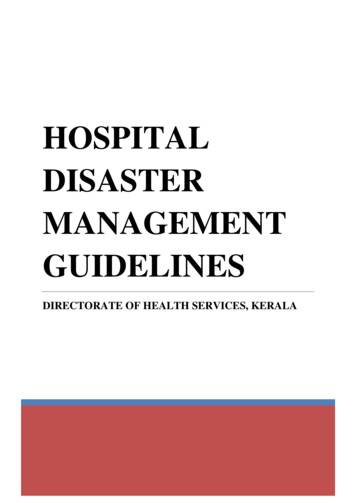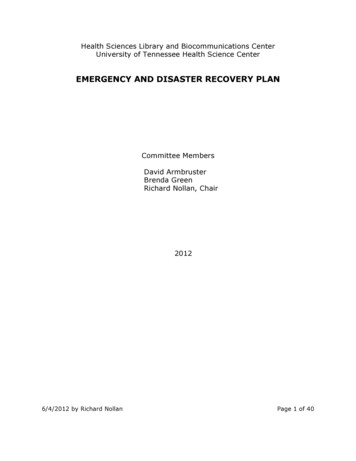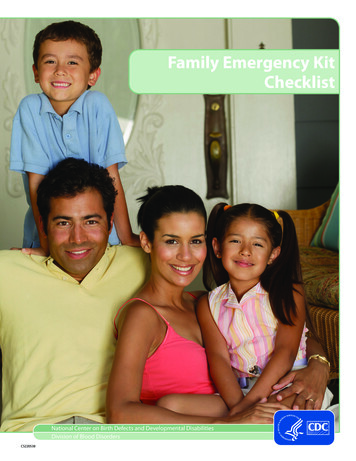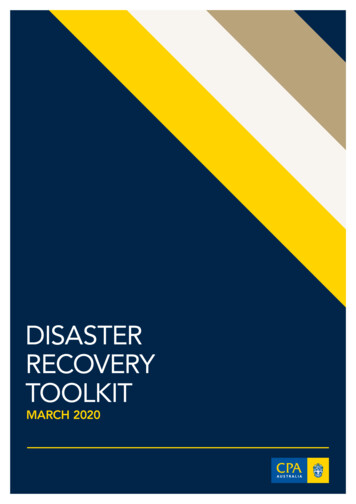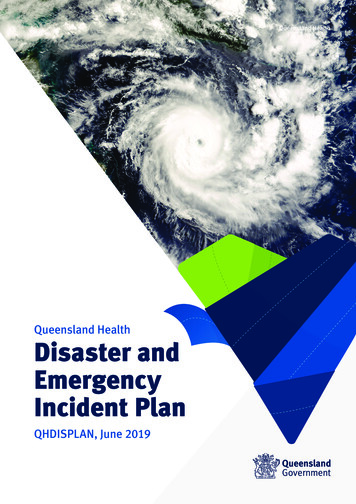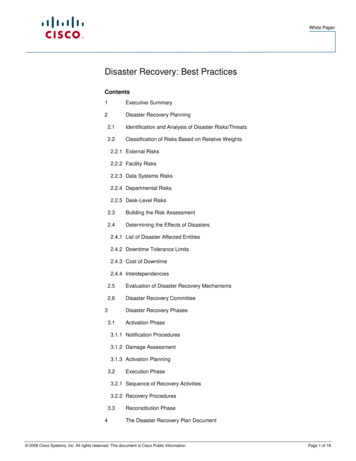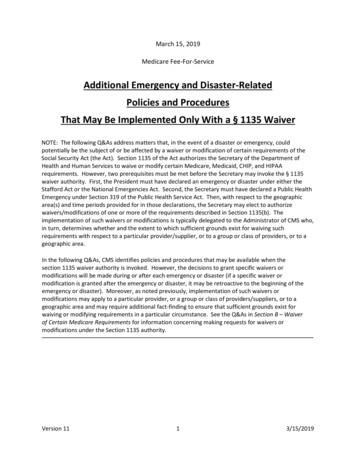
Transcription
March 15, 2019Medicare Fee-For-ServiceAdditional Emergency and Disaster-RelatedPolicies and ProceduresThat May Be Implemented Only With a § 1135 WaiverNOTE: The following Q&As address matters that, in the event of a disaster or emergency, couldpotentially be the subject of or be affected by a waiver or modification of certain requirements of theSocial Security Act (the Act). Section 1135 of the Act authorizes the Secretary of the Department ofHealth and Human Services to waive or modify certain Medicare, Medicaid, CHIP, and HIPAArequirements. However, two prerequisites must be met before the Secretary may invoke the § 1135waiver authority. First, the President must have declared an emergency or disaster under either theStafford Act or the National Emergencies Act. Second, the Secretary must have declared a Public HealthEmergency under Section 319 of the Public Health Service Act. Then, with respect to the geographicarea(s) and time periods provided for in those declarations, the Secretary may elect to authorizewaivers/modifications of one or more of the requirements described in Section 1135(b). Theimplementation of such waivers or modifications is typically delegated to the Administrator of CMS who,in turn, determines whether and the extent to which sufficient grounds exist for waiving suchrequirements with respect to a particular provider/supplier, or to a group or class of providers, or to ageographic area.In the following Q&As, CMS identifies policies and procedures that may be available when thesection 1135 waiver authority is invoked. However, the decisions to grant specific waivers ormodifications will be made during or after each emergency or disaster (if a specific waiver ormodification is granted after the emergency or disaster, it may be retroactive to the beginning of theemergency or disaster). Moreover, as noted previously, implementation of such waivers ormodifications may apply to a particular provider, or a group or class of providers/suppliers, or to ageographic area and may require additional fact-finding to ensure that sufficient grounds exist forwaiving or modifying requirements in a particular circumstance. See the Q&As in Section B – Waiverof Certain Medicare Requirements for information concerning making requests for waivers ormodifications under the Section 1135 authority.Version 1113/15/2019
ContentsALL EMERGENCIES. 3A - Flexibilities Available in the Event of an Emergency or Disaster . 3B - Waiver of Certain Medicare Requirements . 5C – General Payment Policies. 14D – General Billing Procedures. 14E – Physician Services . 16F – Ambulance Services . 17G – Laboratory & Other Diagnostic Services . 19H – Drugs & Vaccines Under Part B . 19I – Durable Medical Equipment, Prosthetics, Orthotics, and Supplies . 19J – End Stage Renal Disease (ESRD) Facility Services . 20K – Home Health Services . 20L – Hospice Services . 22M – Hospital Services – General . 23N – Hospital Services – Emergency Medical Treatment and Labor Act (EMTALA) . 25O – Hospital Services – Acute Care . 29P – Hospital Services – Critical Access Hospitals (CAHS) . 30Q – Hospital Services – Inpatient Rehabilitation Facilities (IRFs) . 31R – Hospital Services – Long Term Care Hospitals (LTCHs) . 32S – Ambulatory Surgical Centers . 32T – Skilled Nursing Facilities . 33U – Mental Health Counseling . 36V – Rural Health Clinics / Federally Qualified Health Centers. 36W – Fee-for-Service Administration. 36X – Financial Management Policies . 36Y – Medicare FFS Appeals . 36Version 1123/15/2019
ALL EMERGENCIESA - Flexibilities Available in the Event of an Emergency or DisasterQuestion Number1135A-1Question and AnswerQuestion: What is the difference between a “flexibility” and a “waiver”?Answer: A “flexibility” is an agency policy or procedure that can be adjusted undercurrent authority – and generally speaking, can be adjusted without reprogrammingCMS’s systems. As used in these FAQs, the terms “waiver or a modification” refer to awaiver or modification of a statutory requirement of the Social Security Act (Act) or itsimplementing regulations that may be waived or modified under the authority of § 1135of the Act or § 1812(f) if the Act, as the case may be. CMS will implement these waiversand flexibilities as necessary and appropriate to accommodate the needs of thoseimpacted by an emergency or disaster.Updated: 9/3/17Version 1133/15/2019
Question Number1135A-2Question and AnswerQuestion: In the event of an emergency or disaster, is assistance available to healthcare providers and suppliers for capital expenditures?Answer: Health care providers and supplier located in declared disaster areas may beeligible for the following disaster assistance for capital expenditures.Federal Emergency Management Agency (FEMA) Public Assistance ProgramThe FEMA Public Assistance Program provides grants to certain private non-profit(PNP) entities including hospital, outpatient facility, rehabilitation facility, long-termcare facility, etc. to assist them with the response to and recovery from disasters.Specifically, the program provides assistance for debris removal, emergencyprotective measures, and permanent restoration of infrastructure. Generally,private, non-profit entities must first apply to the Small Business Administration(SBA) for a disaster loan (see below). If the PNP is declined for a SBA loan or theloan does not cover all eligible damages, the applicant may reapply for FEMAassistance. PNPs that provide "critical services" (power, water - including waterprovided by an irrigation organization or facility, sewer, wastewater treatment,communications and emergency medical care) may apply directly to FEMA for adisaster grant. For more information, go to ibal-and-non-profitSmall Business Administration (SBA) Disaster Assistance LoansFollowing disasters, the U.S. Small Business Administration (SBA) plays a major role.SBA’s disaster loans are the primary form of federal assistance for nonfarm, privatesector disaster losses. Disaster loans from SBA help businesses of all sizes and nonprofitorganizations (including many in health care providers and organizations) fundrebuilding. SBA’s disaster loans are a critical source of economic stimulation in disasterravaged communities, helping to spur employment and stabilize tax bases. Disasterassistance loans make recovery possible when private, non-profit entities need to borrowcapital to repair uninsured damages caused by a disaster. They are low-interest longterms loans that are repaid directly to the Treasury.The SBA is authorized by the Small Business Act to make two types of disaster loans:Physical disaster loans are a primary source of funding for permanent rebuilding andreplacement of uninsured or underinsured disaster damages to privately-owned realand/or personal property. SBA’s physical disaster loans are available to homeowners,renters, businesses of all sizes and nonprofit organizations.Economic injury disaster loans provide necessary working capital until normaloperations resume after a physical disaster. The law restricts economic injury disasterloans to small businesses, small agricultural cooperatives, small businesses engaged inaquaculture and most private, non-profit organizations of all sizes.For more information, contact SBA’s Disaster Customer Service Center by calling (800)659-2955, emailing disastercustomerservice@sba.gov , or visiting SBA’s Web site atwww.sba.gov .1135A-3Medicare Fee-for-Service (FFS)Once these, and other available resources (such as insurance), are exhausted, MedicareFFS assistance may be available to a limited extent. See Qs&As M-2, M-15, and M-16 mergency/Downloads/Consolidated Medicare FFS Emergency QsAs.pdf.Question: Can specific waivers be granted retroactively?Answer: Yes, a specific waiver or modification granted as a result of the emergencymay be retroactive to the beginning of the emergency or disaster if warranted.Updated: 9/3/17Version 1143/15/2019
B - Waiver of Certain Medicare RequirementsQuestion Number1135B-1Question and AnswerQuestion: Can Medicare rules be waived in a disaster or emergency?Answer: In this circumstance, Medicare coverage or payment rules cannot be waived,even in a disaster or emergency. However, subject to certain pre-conditions being met,the Secretary of the Department of Health and Human Services may authorize the waiveror modification of certain requirements that relate to the Medicare, Medicaid, and theChildren’s Health Insurance Programs under the authority of § 1135 of the SocialSecurity Act (Act), and some of these waivers or modifications may have an indirecteffect on the application of Medicare fee-for-service coverage or payment rules in anemergency or disaster.The preconditions that must be met before the Secretary can invoke the authority towaive or requirements under the § 1135 authority are that:1. The President must have declared an emergency or disaster under either theStafford Act or the National Emergencies Act, and2. The Secretary must have declared a Public Health Emergency under Section 319of the Public Health Service Act.Then, with respect to the geographic area(s) and time periods to which both of thosedeclarations apply, the Secretary may elect to authorize waivers/modifications of one ormore of the requirements described in Section 1135(b).The implementation of such waivers or modifications is largely handled by CMS whichdetermines whether and the extent to which sufficient grounds exist for waiving ormodifying such requirements with respect to a particular provider, or to a group or classof providers, or to a geographic area within the emergency area.Version 1153/15/2019
Question Number1135B-2Question and AnswerQuestion: What rules can be waived under § 1135?Answer: Very few rules can be waived or modified under current law, even in a disasteror emergency. Section 1135 of the Act authorizes the Secretary of the Department ofHealth and Human Services to waive, or some cases modify, certain requirements thatrelate to the Medicare, Medicaid, and the Children’s Health Insurance Programs. Therequirements that the Secretary may waive or modify, in an emergency area and duringan emergency period, are, in summary:1. a. conditions of participation or other certification requirements for an individualhealth care provider or types of providers;b.program participation and similar requirements for an individual health careprovider or types of providers; andc. pre-approval requirements.2. requirements that physicians and other health professional be licensed in theState in which they provide services, if they provide equivalent services inanother State and are not affirmatively excluded from practice in that State orin any state a part of which is included in the emergency area.3. actions under EMTALA rules (per § 1867 of the Act) regarding:a. the transfer of an individual who has not been stabilized (if the transferarises out of the circumstances of the emergency) ; andb. the direction or relocation of an individual to receive medical screening atan alternative location in accordance with an appropriate (and applicable)State preparedness plan.4. sanctions for violations of Stark rules (physician self-referral under § 1877 ofthe Act).5. deadlines and timetables for performance of required activities (may bemodified but not waived).6. limitations on the ability to make direct payments to providers for servicesprovided to Medicare Advantage enrollees.7. sanctions and penalties for noncompliance with certain patient privacyprovisions of the Health Insurance Portability and Accountability Act of 1996(HIPAA).Note that HIPAA and EMTALA waivers are subject to special time limitations.In addition to these § 1135-based waivers or modifications, in situations where the useof 1135 authority is appropriate, CMS may consider exercising authority under § 1812(f)to waive the 3-day prior hospital stay requirement for coverage of a SNF stay.Q&As in the following sections discuss the application of these waivers and modificationsin the context of Medicare fee-for-service, in greater detail.Version 1163/15/2019
Question Number1135B-3Question and AnswerQuestion: How does the President’s National Emergency declaration under the NationalEmergencies Act differ from a Stafford Act declaration? How does the request processfor assistance under the Stafford Act differ from the request process for 1135 waivers?Answer: Presidential proclamation of a national emergency under the NationalEmergencies Act and aPresidential declaration of an emergency or major disaster under the Stafford Act aredistinct and separate declarations.The National Emergencies Act allows the President to issue a proclamation to invokeparticular emergency authorities as needed. The President’s proclamation under theNational Emergencies Act does not trigger a Stafford Act declaration or provide financialor other resources.In general, when an incident overwhelms or is anticipated to overwhelm State resources,the Governor may request Federal assistance, including assistance under the StaffordAct. The Stafford Act authorizes the President to provide financial and other assistanceto State and local governments, certain private nonprofit organizations, and individualsto support response, recovery, and mitigation efforts following Presidential emergency ormajor disaster declarations under the Stafford Act. The Stafford Act is triggered by aPresidential declaration of a major disaster or emergency under that Act, when an eventcauses damages of sufficient severity and magnitude to warrant Federal disasterassistance to supplement the efforts and available resources of States, localgovernments, and the disaster relief organizations in alleviating the damage, loss,hardship, or suffering.1135B-4Most incidents are not of sufficient magnitude to warrant a Presidential declaration.However, if State and local resources are insufficient, a Governor may ask the Presidentto make such a declaration. Ordinarily only a Governor can initiate a request for aPresidential emergency or major disaster declaration. In extraordinary circumstances,the President may unilaterally declare a major disaster or emergency. In order to assistStates in assessing impacts and evaluating the need for Federal assistance in anemergency or disaster, FEMA may develop a fact sheet for requesting Stafford Actassistance from the Federal government.For example, FEMA developed such a fact sheet for the H1N1 influenza pandemic, whichmay be viewed at:http://www.fema.gov/pdf/emergency/pandemic influenza fact sheet.pdf.Question: Specifically, what will a National Emergencies Act Declaration enable? Whatwill 1135 waivers allow hospitals to do if a waiver is requested and granted?1135B-5Answer: For purposes of section 1135 waivers or modifications, the President’sdeclaration of a national emergency fulfills one of the two conditions required for theSecretary of HHS to be able to invoke the 1135 waiver authority. The other condition isthat the Secretary has determined that a public health emergency exists in the samegeographic area and time frame. If both conditions are met and the Secretary hasinvoked the 1135 waiver authority, then healthcare facilities that receive specific waiversor modifications under section 1135 will be able to continue to be reimbursed for coveredservices even if they are out of compliance with certain Medicare, Medicaid and CHIPrequirements.Question: Do 1135 waivers affect State laws or regulations?1135B-6Answer: Under section 1135, only certain Federal requirements relating to Medicare,Medicaid, CHIP, and HIPAA may be waived or modified. An 1135 waiver does not affectState laws or regulations.Question: Has the authority to grant 1135 waivers been exercised before?Answer: Yes, there are several instances where 1135 waiver authority has beeninvoked to help healthcare facilities cope with large patient burdens. Recent examplesinclude Hurricane Katrina (2005), Hurricanes Ike and Gustav (2008), and the NorthDakota flooding (2009 & 2010) and the H1N1 pandemic (2009 – 2010). The Secretarywas also prepared and able to invoke the 1135 waiver authority in connection with the56th Presidential Inauguration (2009) in the event that 1135 waivers became necessary.Version 1173/15/2019
Question Number1135B-7Question and AnswerQuestion: Is the HIPAA Privacy Rule suspended during a national or public healthemergency?Answer: No. The HIPAA Privacy Rule is not suspended during a national or publichealth emergency. However, the Secretary of HHS may waive certain sanctions andpenalties against a covered hospital that does not comply with certain provisions of theHIPAA Privacy Rule under section 1135(b)(7) of the Social Security Act.Specifically, the Secretary of HHS may waive sanctions and penalties against a coveredhospital that does not comply with the following provisions of the HIPAA Privacy Rule: (1)the requirements to obtain a patient's agreement to speak with family members orfriends involved in the patient’s care (45 CFR 164.510(b)); (2) the requirement to honora request to opt out of the facility directory (45 CFR 164.510(a)); (3) the requirement todistribute a notice of privacy practices (45 CFR 164.520); (4) the patient's right torequest privacy restrictions (45 CFR 164.522(a)); and (5) the patient's right to requestconfidential communications (45 CFR 164.522(b)). These waivers are subject to specialtime limits.The HHS Office for Civil Rights (OCR) enforces the HIPAA Privacy Rule, which protectsthe privacy of individually identifiable health information; the HIPAA Security Rule, whichsets national standards for the security of electronic protected health information; andthe confidentiality provisions of the Patient Safety Rule, which protect identifiableinformation being used to analyze patient safety events and improve patient safety.Additional information concerning these matters can be accessed at the OCR 1135B-8Question: When and where are 1135 waivers (not related to HIPAA) in effect?Answer: The Secretary may issue specific waivers or modifications under section 1135only to the extent they ensure that sufficient health care items and services are availableto meet the needs of Medicare, Medicaid, and CHIP beneficiaries in the emergency areaduring the emergency period. The “emergency area” and the “emergency period” arethe geographic area, in which, and the time period, during which, the dual declarationsexist.Version 1183/15/2019
Question Number1135B-9Question and AnswerQuestion: What are practical implementation steps States and individual healthcareproviders need to consider when seeking a waiver or modification of requirements duringan emergency or disaster?Answer: Determining if Waivers Are NecessaryIn determining whether to recommend that the Secretary invoke the 1135 waiverauthority (once the conditions precedent to the authority’s exercise have been met), theAssistant Secretary for Preparedness and Response (ASPR), with input from relevantHHS Operating Divisions, will determine the need and scope for such modifications.Information considered includes requests from Governors’ offices, feedback fromindividual healthcare providers and associations, and requests to regional or field officesfor assistance. If the Secretary invokes the waiver authority, then 1135 waivers andmodifications are authorized.How States or Individual Healthcare Providers Can Ask for Assistance or a WaiverOnce the 1135 waiver is authority is invoked, health care providers can submit requeststo operate under that authority or for other relief that may be possible outside theauthority to either the State Survey Agency or CMS Regional Office. Requests can bemade by sending an email to the CMS Regional Office in their service area, or by callingthe State or CMS Regional Office. Email addresses are listed below. The requestingentity should furnish all pertinent facts concerning its particular situation and how itwould operate under the particular waiver it is seeking.Review of 1135 Waiver requestsA cross-regional CMS Waiver Validation Team will review waiver requests to ensure theyare justified and supportable.Implementation of 1135 Waiver AuthorityProviders must resume compliance with normal Medicare fee-for-service rules andregulations as soon as they are able to do so and, in any event, the waivers ormodifications a provider was operating under are no longer available after thetermination of the emergency period. Note that HIPAA and EMTALA waivers are subjectto special time limits, as discussed elsewhere in these FAQs.All Medicare-enrolled providers must operate under normal Medicare fee-for-service rulesand regulations, unless they have sought and have been granted waivers ormodifications under the 1135 waiver authority of specific requirements.Email Addresses for CMS Regional OfficesROATLHSQ@cms.hhs.gov (Atlanta RO): Alabama, Florida, Georgia, Kentucky,Mississippi, North Carolina, South Carolina, TennesseeRODALDSC@cms.hhs.gov (Dallas RO): Arkansas, Louisiana, New Mexico, Oklahoma,TexasROPHIDSC@cms.hhs.gov (Northeast Consortium): Delaware, District of Columbia,Maryland, Pennsylvania, Virginia, West Virginia, New York, New Jersey, Puerto Rico,Virgin Islands, Connecticut, Maine, Massachusetts, New Hampshire, Rhode Island,VermontROCHISC@cms.hhs.gov (Midwest Consortium): Illinois, Indiana, Michigan, Minnesota,Ohio, Wisconsin, Iowa, Kansas, Missouri, NebraskaROSFOSO@cms.hhs.gov (Western Consortium): Colorado, Montana, North Dakota,South Dakota, Utah, Wyoming, Alaska, Idaho, Oregon, Washington, Arizona, California,Hawaii, Nevada, Pacific Territories.Version 1193/15/2019
Question B-15Question and AnswerQuestion: Approximately how long will the process take for approving/denying a waiverrequest?Answer: CMS will review and validate the 1135 waiver requests utilizing a crossregional Waiver Validation Team. The cross-regional Waiver Validation Team will reviewwaiver requests to ensure they are justified and supportable. HHS anticipates thatrequests to operate under 1135 Waiver flexibilities should be responded to within threebusiness days of receipt.Question: Can a healthcare system apply for a waiver of regulations at all or some ofits hospitals, or can only a hospital apply?Answer: HHS anticipates that healthcare systems or corporations may make requestson behalf of their facilities. However, they should include the information necessary toallow the CMS regional office to appropriately justify the flexibility requested for eachfacility.Question: Can a county health department apply on behalf of several hospitals in itscounty or must each hospital apply individually?Answer: A county may apply on behalf of facilities in its county, but the county shouldsupply all pertinent facts concerning each facility’s particular situation, and how thefacility would operate under the particular waiver it is seeking, in order to enable theCMS regional office to appropriately justify the waiver or modification requested for eachfacility.Question: Can a State petition the Federal government for a waiver covering all CriticalAccess Hospitals (CAH) and if so, to whom?Answer: Health care providers can submit requests to operate under that authority (orfor other relief that may be possible under other authority) to either the State SurveyAgency or CMS Regional Office. Requests can be made by sending an email to the CMSRegional Office in their service area, or by calling the State or CMS Regional Office.Information on your facility and justification for requesting the waiver or modification willbe required.Question: Can the 72-hour waiver time frame for HIPAA and EMTALA waivers under thesection 1135 authority be extended if the disaster plan is still in effect?Answer: No. These waivers, when applicable, are limited to a 72-hour period beginningupon implementation of a hospital disaster protocol, except in the case of a public healthemergency involving a pandemic infectious disease – for these emergencies EMTALAwaivers may be effective until the termination of the emergency period.Question: Are there mechanics for requesting a waiver or modification under section1135 proactively?Answer: Health care providers in the emergency area are asked to submit supportedand justifiable requests reflecting actual need for a waiver or modification of applicablerequirements as the need arises (i.e., rather than in anticipation of a need). Therequesting entity should furnish all pertinent facts concerning its particular situation, andhow it would operate under the particular waiver it is seeking, to ensure that the WaiverValidation Team can validate the request quickly. Requested waivers or modificationscan be approved effective retroactively to the beginning of the emergency period.Version 11103/15/2019
Question Number1135B-16Question and AnswerQuestion: To whom and in what form should a hospital “petition” for an 1135 waiver?Answer: Health care providers can submit requests to operate under that authority (orfor other relief that may be possible under other authority) to either the State SurveyAgency or CMS Regional Office. Requests can be made by sending an email to the CMSRegional Office in their service area, or by calling the State or CMS Regional Office.Email addresses are listed below. Information on your facility and justification forrequesting the waiver or modification will be required.ROATLHSQ@cms.hhs.gov (Atlanta RO): Alabama, Florida, Georgia, Kentucky,Mississippi, North Carolina, South Carolina, TennesseeRODALDSC@cms.hhs.gov (Dallas RO): Arkansas, Louisiana, New Mexico, Oklahoma,TexasROPHIDSC@cms.hhs.gov (Northeast Consortium): Delaware, District of Columbia,Maryland, Pennsylvania, Virginia, West Virginia, New York, New Jersey, Puerto Rico,Virgin Islands, Connecticut, Maine, Massachusetts, New Hampshire, Rhode Island,VermontROCHISC@cms.hhs.gov (Midwest Consortium): Illinois, Indiana, Michigan, Minnesota,Ohio, Wisconsin, Iowa, Kansas, Missouri, Nebraska1135B-17ROSFOSO@cms.hhs.gov (Western Consortium): Colorado, Montana, North Dakota,South Dakota, Utah, Wyoming, Alaska, Idaho, Oregon, Washington, Arizona, California,Hawaii, Nevada, Pacific Territories.Question: Must a State or locality declare its own public health emergency (PHE) beforeit may request that an 1135 be put into place for one or more of its healthcare facilities?If so, is it possible for a hospital in a State that has not declared a PHE to petitiondirectly to HHS for an 1135 waiver? If so, what is the process?Answer: A state or locality’s declaration of an emergency has no bearing on theSecretary’s authority to invoke the section 1135 waiver authority. Rather, so long as theSecretary has declared a public health emergency and the President has declared anemergency or disaster under the Stafford Act or National Emergencies Act for therelevant geographic area, the Secretary may invoke the 1135 authority and authorizewaivers or modifications of certain Medicare, Medicaid, CHIP and HIPAA requirements inthe geographic area during the period when the declarations are in effect. However, thefact that a State or locality has declared an emergency or requested federal assistance inresponse to an emergency may be relevant to the Secretary’s consideration of
SBA's disaster loans are the primary form of federal assistance for nonfarm, private sector disaster losses. Disaster loans from SBA help businesses of all sizes and nonprofit organizations (including many in health care providers and organizations) fund rebuilding. SBA's disaster loans are a critical source of economic stimulation in disaster
